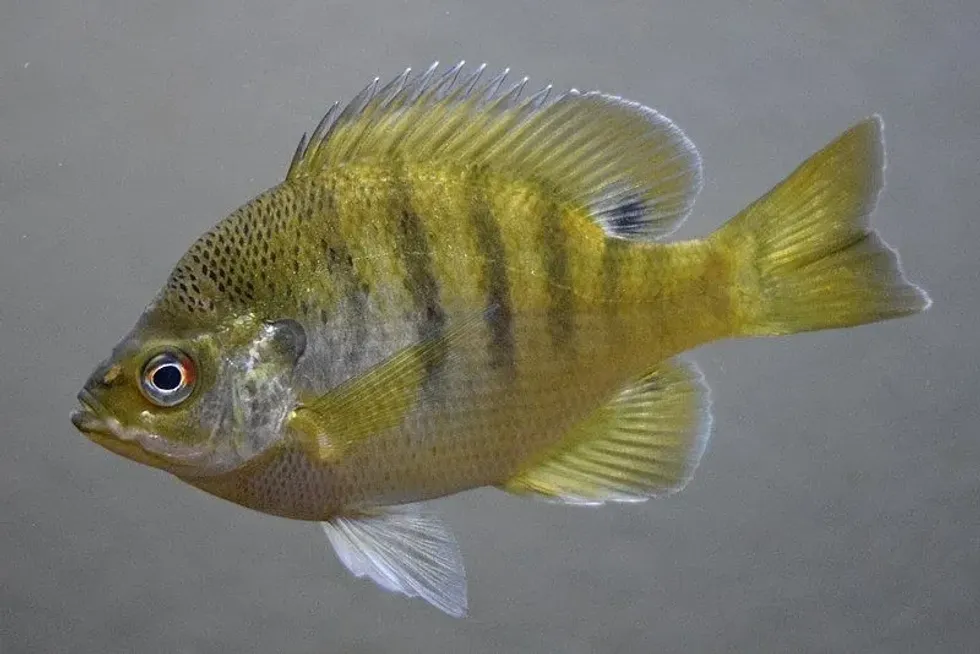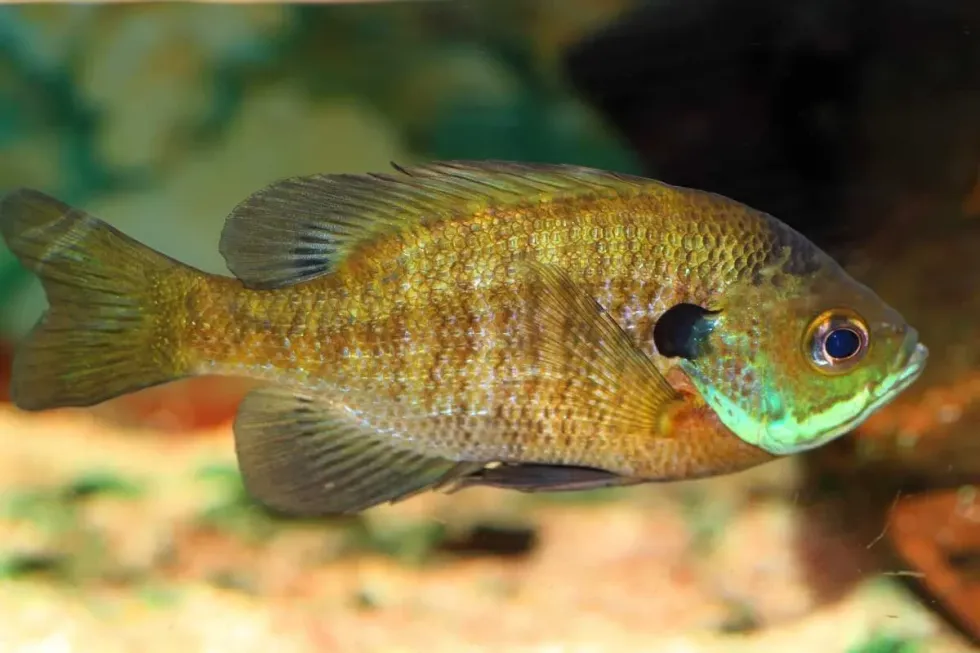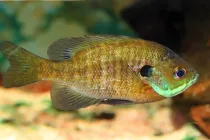Fun Bluegill Facts For Kids

Bluegill (Lepomis macrochirus) is a freshwater panfish that makes a popular choice as a game fish throughout the central and southern parts of the United States. They are very popular in the sunfish family.
They have been introduced to many freshwater lakes, ponds, rivers, and streams and are distributed throughout the western United States. Bluegills live in shallow water but often go into deep weed beds in search of food or with the purpose of spawning.
In the wild, they swim together in schools of 10 to 20 fish. The bluegill growth rate depends on the type and amount of food it eats.
A healthy fish that gets plenty of nutritious food required for its growth will grow faster than one that consumes less food. Their small mouth allows them to eat microscopic creatures.
If you are interested to know more about the habits and behavior of bluegills, then here are some fascinating facts about this fish. For relatable content, check out our articles on cuttlefish and Siamese fighting fish.
Bluegill Interesting Facts
What type of animal is bluegill?
Bluegill (Lepomis macrochirus) is a small to medium-sized freshwater fish of the sunfish family Centrarchidae. Bluegills are one of the most famous species of sunfish and are also known by a variety of other names like copper nose, bluegill bream, and bluegill sunfish.
What class of animal does bluegill belong to?
Bluegill fish of the Perciformes order belongs to the class Actinopterygii. This is the same class of aquatic ray-finned and bony fish.
How many bluegills are there in the world?
The bluegill population of the world is not known yet. They are commonly visible and found in abundance in their places of origin.
Scientists believe that their population has been following a stable pattern over the years and do not face any threat of being endangered. However, due to their varied range, it has become quite difficult to determine their exact population.
Where does Bluegill live?
Bluegills are a native fish species of North America. They are found in large numbers in streams and lakes situated on the east of the Rocky Mountains extending its range from the coasts of Virginia to Florida, to Texas in the west, from north to the west of Minnesota covering western New York, and from Quebec to northern Mexico.
This species of fish covers most of Central and Eastern America.
Bluegills are native to freshwater lakes and ponds of the Mississippi River systems, the Great Lakes, and the St. Lawrence.
At present, they have crossed their native habitat and have been introduced into freshwater streams in Europe, Oceania, Asia, South Africa, Zimbabwe, and South America. In some places like Japan and Germany, bluegills are seen as invasive species, and therefore trading them is banned in those places.
What is a bluegill's habitat?
Bluegills are freshwater fish inhabiting slow-moving and sluggish rivers, lakes, ponds, rocky streams, creeks, and reservoirs. They prefer to stay in shallow water covered with dense aquatic plants.
This type of fish nests within or near wooden logs present underwater or on underground beds of weed. The fallen logs also provide the fish protection from its predators in the wild.
Young fish tend to live near the covered areas while the adults swim in open waters. During summer, the adult fish move to deep water and float just above the water bed.
The ideal water temperature range for bluegill should be between 61-81 F (16-27 C). They wander in a shallow depth under the water's surface during the morning to absorb heat and stay warm.
Although they are a common freshwater fish, the availability of bluegills in the salty water of Chesapeake Bay tributaries indicates that this sunfish species can tolerate a little amount of salinity in their natural habitat. The most favorable habitat of bluegill is oxbow lakes.
Who do bluegills live with?
Bluegills are schooling fish. Normally a school of bluegills consists of 10 to 20 fish.
However, sometimes larger and aggregated groups can also be observed. Their schools are not homogeneous which means that a bluegill school can contain various other species of sunfish like smallmouth bass, crappie, and pumpkinseed. Bluegill individuals belonging to the same school search for food together as well as protect each other from predators.
How long does bluegill live?
A bluegill is a popular target of many predators in the wild. However, in the wild, they can live up to four to six years in their nests without facing any threat. In captivity, their lifespan increases and they can stay alive for about eight to 11 years old.
How do they reproduce?
The bluegill breeding season starts in the summer and extends to the start of the rainy season. Their spawning reaches its peak in June when the water temperature is around 66-81 F (19-27 C).
Males first arrive at the breeding site and build a nest by scooping sand and gravel from the ground. A male bluegill becomes very protective of its spawning bed and does not let anyone approach it except a female.
A male fish waits at the breeding nest and makes grunting noises to attract females toward it. When a female enters the nest, the male starts to swim in circles which attracts female bluegills.
Female bluegills are attracted to large-bodied males.
After this display, if the female stays in the nest then they mate. Males and females release sperms and eggs which fertilize in the water externally.
After the breeding process is over, males chase away the females and guard the eggs alone. Female bluegill can lay eggs in several nests and a single nest is used by several females to lay eggs.
Female bluegills normally reach sexual maturity at one year of age but under favorable conditions, they might start reproducing at four months. The number of eggs that they produce varies according to the size of their body with smaller fish producing 1000 eggs and larger ones laying several thousand.
What is their conservation status?
A member of the sunfish family, bluegills are enlisted as animals of Least Concern in the IUCN Red List. There is not much information regarding their population number and population densities. However, reports say that this fish does not face any danger of extinction shortly.
Bluegill Fun Facts
What do bluegills look like?
Like all sunfish, bluegills also have a compressed and tall body shape. They have flat bodies with a small mouth at the anterior part of the head.
The tail fin of the fish looks slightly forked with a continuous and spiny dorsal fin. At the base of the dorsal fin and on the posterior sides of the gill, bluegills have a unique large black spot which is also called the ear which differentiates them from other sunfish like Red-ear sunfish and Orange-spotted sunfish.
This fish gets its name from its blue-colored head, its cheek, and its gill cover called the opercle. They have a yellow abdomen while the abdomen turns orange in a breeding male fish.
Bluegills display five to nine olive-colored vertical bars on each side of their body when they face a threat. Their body colors vary due to the presence of chromatophores under the skin.

How cute are they?
Bluegills are flat fish. Their cuteness is subjective and depends upon the perspective of people. They are colorful and that makes them quite cute. Many kids want to draw and color them. You can draw a cute bluegill fish for yourself by following these easy steps.
Start by drawing a wide fish-shaped body by extending the up and the down portion. Next, add a smooth fork-shaped tail and a dorsal fin with spines on it. Finish it off by detailing the face by drawing large circular eyes and the black spot on the posterior end.
How do they communicate?
Fish communicate by several methods. The most common communication methods of fish include color, motion, sound, scent, and electrical impulses. Communication in fish helps them to navigate as well as to reproduce. Male bluegill changes its abdomen color to orange during the breeding period. Grunting is also used as mating calls in bluegills.
How big is a bluegill?
The average adult bluegill size is 8 in (20.3 cm). Their length ranges from 7.5 in (19.1 cm) and can attain a maximum length of 16 in (41 cm). They reach their full size at the age of about five years. A bluegill fish is more than five times smaller than its common predator, the largemouth bass.
How fast can bluegill swim?
Bluegills can swim very fast and their speed is measured by the unit of light's speed. The maximum speed that bluegill can attain is measured to be 2.14 l/s.
How much does a bluegill weigh?
The weight of an adult and full-grown bluegill ranges from 2.6-4.9 lb (1.2-2.2 kg).
What are the male and female names of the species?
Male and female fish do not have any specific names. Both species are collectively known as bluegills.
What would you call a baby bluegill?
A baby fish is called a 'fry'. Likewise, baby bluegill is also called a 'fry'.
What do they eat?
Bluegill is omnivorous. They feed on anything that practically fits their small mouth. Their diet includes small invertebrates like shrimp, worms, crustaceans, snails, insects, zooplankton, and small crayfish. They can also feed on some small fish like minnows and fish eggs.
Bluegill feeds when they move to shallow waters, mainly during dusk or dawn. They feed on a plant diet only in the absence of their prey. Baby fish also feed on algae or zooplankton.
Are they eaten by humans?
Bluegill is panfish which means that they are edible and their size does not exceed the size of frying pans. Due to their small size, this fish is very healthy and has a low-fat content.
It is pretty easy to catch bluegill using common bluegill bait like shrimp, grasshoppers, crickets, and worms. Bluegills form one of the tastiest Indiana dishes. The ones that are caught in the wild are equally safe to eat as the ones that are bought commercially.
Would they make a good pet?
Bluegills are happier in the wild than as a pet. It requires a minimum tank size of 50 gal (189 l) which can cost a huge sum.
It is also difficult to imitate their natural habitat and provide them with similar food they would find in the wild. Since they are carnivorous, they are often given shiners for food in aquariums
Did you know...
Bluegills are used for producing a variety of hybrid fish within the Lepomis genus but the most famous Lepomi hybrid is the greengill.
What eats bluegill?
Bluegills are a common diet of many aquatic as well as terrestrial animals. In water, they form the most common food source for largemouth bass. There are some other fish that prey on bluegills like muskellunge, walleye, white bass, and striped bass.
Some terrestrial predators of bluegills include kingfishers, raccoons, great blue herons, and even humans. Bluegill takes cover in the wooden logs when they face danger. They generally stay hidden during the day and come out at night in schools.
What was the biggest bluegill ever caught?
Bluegills are generally medium-sized fish found in freshwater lakes. In 1950 in Ketona Lake in Alabama, the world record bluegill recorded by the International Gamefish Association or the IGA was caught.
This bluegill was 15 in (38.1 cm) in length and had a girth of about 18.25 in (46.4 cm). The weight of the fish was 4.75 lb (2.2 kg).
Here at Kidadl, we have carefully created lots of interesting family-friendly animal facts for everyone to discover! Learn more about some other fish including parrot fish or silver dollar.
You can even occupy yourself at home by drawing one on our Bluegill fish coloring pages.
We Want Your Photos!
More for You
See All
Bachelor of Arts specializing in Journalism and Mass Communication, Postgraduate Diploma in Sports Management

Moumita DuttaBachelor of Arts specializing in Journalism and Mass Communication, Postgraduate Diploma in Sports Management
A content writer and editor with a passion for sports, Moumita has honed her skills in producing compelling match reports and stories about sporting heroes. She holds a degree in Journalism and Mass Communication from the Indian Institute of Social Welfare and Business Management, Calcutta University, alongside a postgraduate diploma in Sports Management.
Bachelor of Law

Abdulqudus MojeedBachelor of Law
A versatile professional with a passion for creative writing and technology. Abdulqudus is currently pursuing his Bachelor of Law from the University of Lagos and has experience as a tutor, intern assistant, and volunteer. He possesses strong organizational skills and is a detail-oriented person.
Disclaimer
1) Kidadl is independent and to make our service free to you the reader we are supported by advertising. We hope you love our recommendations for products and services! What we suggest is selected independently by the Kidadl team. If you purchase using the Buy Now button we may earn a small commission. This does not influence our choices. Prices are correct and items are available at the time the article was published but we cannot guarantee that on the time of reading. Please note that Kidadl is a participant in the Amazon Services LLC Associates Program, an affiliate advertising program designed to provide a means for sites to earn advertising fees by advertising and linking to Amazon. We also link to other websites, but are not responsible for their content.
2) At Kidadl, we strive to recommend the very best activities and events. We will always aim to give you accurate information at the date of publication - however, information does change, so it’s important you do your own research, double-check and make the decision that is right for your family. We recognise that not all activities and ideas are appropriate for all children and families or in all circumstances. Our recommended activities are based on age but these are a guide. We recommend that these ideas are used as inspiration, that ideas are undertaken with appropriate adult supervision, and that each adult uses their own discretion and knowledge of their children to consider the safety and suitability. Kidadl cannot accept liability for the execution of these ideas, and parental supervision is advised at all times, as safety is paramount. Anyone using the information provided by Kidadl does so at their own risk and we can not accept liability if things go wrong.
3) Because we are an educational resource, we have quotes and facts about a range of historical and modern figures. We do not endorse the actions of or rhetoric of all the people included in these collections, but we think they are important for growing minds to learn about under the guidance of parents or guardians.







